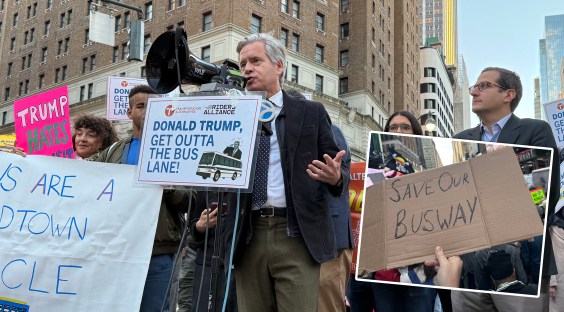Trump Blocks 34th Street Busway as DOT Shrugs, Midtown Pols Demand a Reroute

The sudden federal move to halt New York’s flagship busway on 34th Street betrays the fragility of local transit innovation in the face of national politics.
On a recent Friday evening in Midtown, a chorus of elected officials, transit advocates, and perturbed New Yorkers converged along 34th Street, a stretch of asphalt that has become both battleground and symbol. Their plaint: that President Trump and the federal government are putting a halt to the city’s plan for a dedicated busway—disrupting both public transit ambitions and the well-lubricated rhythms of urban mobility. Trucks rumbled by. Buses, now sluggish in mixed traffic, stood as mute testament to policies in flux.
Only hours earlier, the Federal Highway Administration (FHWA), under Administrator Sean McMaster, sent a curt letter to city and state transportation departments instructing them to immediately pause construction. The missive cited alleged procedural lapses and vague worries about emergency vehicle access, despite neither trucks nor first responders being excluded from the plan. Its timing, days after the city’s congestion pricing scheme encountered similar federal friction, was as striking as its lack of technical substance.
At the heart is New York’s decades-long quest to elevate transit above the city’s chronic gridlock and air pollution. The 14th Street busway, a pilot born of the same aspirations in 2019, now reliably moves over 28,000 daily riders—improving speeds by up to 30%. The 34th Street busway, scheduled to follow suit, had drawn cautious optimism from planners and residents alike. That optimism now finds itself bruised—paused by a White House intent on flexing federal muscle in the nation’s capital of mass transit.
The immediate casualty is practical: more than 40,000 daily commuters on the M34 and M34A buses will lose out on projected gains in travel time, reliability, and quality of life. For the Department of Transportation, helmed by Ydanis Rodriguez, the pause is both tactical and uneasy. Rodriguez gamely insisted the design complies with federal rules and expressed confidence the project would eventually proceed. But many, including State Senator Brad Hoylman-Sigal, viewed the city’s compliance as “bending the knee”—echoing a sense of capitulation rather than strategy.
Beyond the bureaucratic theater, implications for New York are substantial. The city’s status as a national testbed for transit innovation is imperiled; other municipalities may now hesitate before launching projects dependent on federal funds or goodwill. Moreover, the logjam highlights the perennial tension between local control and federal oversight, especially as urban voters’ priorities—speed, reliability, a nudge toward greener transport—grate against an administration prone to ideological grandstanding.
There are less visible but potent second-order effects. Suspensions to projects like the busway, and the earlier roadblocks to congestion pricing, threaten billions in anticipated funding for New York’s aging transit infrastructure. Each delay delays not just service upgrades but job creation and environmental benefits. The political signal, meanwhile, is unmissable: a White House ready to insert itself in routine urban planning decisions, risking a precedent where municipalities govern at the mercy of shifting national winds.
Federal arm-twisting offers little resolve for systemic issues plaguing New York, or other dense cities—namely, how to persuade more people to ride the bus or bike, not just drive. By comparison, other global metropolises prove less impeded by federal caprice. London’s Transport for London, for example, operates under robust, semi-autonomous authority—implementing congestion charges and bus lanes with relatively little central government interference. In Paris, much-touted mobility plans unfold with brisk predictability. Both cities now enjoy higher bus speeds and lower emissions.
America’s infrastructure federalism, in contrast, remains an awkward halfway house. Local governments wield substantial responsibility, but major projects run afoul of federal sign-off and funding entanglements. Trump’s administration, both past and present, has proved willing to weaponise such entanglements for political or rhetorical advantage, with a keen eye for the symbolism of New York—dogged nemesis and beloved backdrop alike.
A city caught in the crossfire
The ensuing legal standoff could be protracted; DOT guidance is silent on timetables and remedies for such impasses. Certain ironies abound: the FHWA’s concern over vehicle movement stands at odds with real-world evidence from the 14th Street busway, where emergency services report faster response times and smoother traffic flow. The rationale, much like the paper it was printed on, appears threadbare.
For New Yorkers, policy by presidential pen-stroke bodes poorly. Gridlock, already endemic, turns marginally worse; environmental targets inch further away. Transit equity—heretofore a parlor promise—becomes harder to guarantee. Each frustrated bus rider sees not just a longer commute, but also the sorry spectacle of municipal leaders held hostage to federal theatrics.
Such central-local antagonism, while not new, is newly acute. Last year’s congestion pricing spat between Washington and City Hall played out in similarly dramatic, if ultimately inconclusive, fashion. Indeed, the predictable cycle—city proposes, feds dispose—has induced planning fatigue among New Yorkers craving not utopia, but at least predictability.
We reckon this is a contest between expertise and expedience, between metropolitan autonomy and the Trump administration’s episodic interventions. The technical merits of New York’s busways are uncontroversial by world standards; what is in dispute is who gets to govern urban mobility in a megacity whose rhythms and woes are little understood on the Potomac. Federalism’s genius lies in letting cities try, fail, and—occasionally—succeed on their own terms.
Until that genius is given freer rein, New York’s streets will remain hostage to the vagaries of national politics—a fate as unedifying as the city’s signature crosstown traffic jams. ■
Based on reporting from Streetsblog New York City; additional analysis and context by Borough Brief.